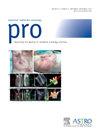Prospective Evaluation of Supplemental External Beam Radiation Therapy With Palladium-103 Prostate Brachytherapy: Long-Term Results of the 44/20/0 Trials
IF 3.5
3区 医学
Q2 ONCOLOGY
引用次数: 0
Abstract
Purpose
The 44/20 and 20/0 randomized trials evaluated whether different external beam radiation therapy (EBRT) dosing regimens prior to brachytherapy affected biochemical failure (BF). We report long-term outcomes of both trials and evaluate whether biological equivalent dose (BED) was associated with reduced BF in the combined trial cohort.
Methods and Materials
Both trials enrolled patients with clinical T1c to T2b, Gleason scores 7 to 9, and/or a pretreatment prostate-specific antigen (PSA) 10 to 20 ng/mL disease. The 44/20 trial randomized patients to 44 Gy EBRT with 90 Gy palladium (Pd)-103 versus 20 Gy EBRT with 115 Gy Pd-103. The subsequent 20/0 trial randomized patients to the 20 Gy arm versus monotherapeutic 125 Gy Pd-103. For each trial, univariate Fine–Gray analysis evaluated whether the treatment arm was associated with BF for the entire cohort and the unfavorable intermediate-risk (UIR) subgroup. For the combined trial cohort, multivariate Fine–Gray analysis evaluated whether BED was associated with BF while adjusting for clinical factors.
Results
There were 247 analyzable patients in the 44/20 trial. At a median follow-up of 13.7 years, there were no differences in BF for the entire cohort (subdistribution hazard ratio [sHR] 0.99; 95% CI, 0.43, 2.276; P = .97) or the UIR subgroup (sHR 0.72; 95% CI, 0.25, 2.08; P = .55). There were 383 analyzable patients in the 20/0 trial. At a median follow-up of 10.4 years, there were no differences in BF for the entire cohort (sHR 0.42; 95% CI, 0.13-1.80; P = .15) or the UIR subgroup (sHR 0.81; 95% CI, 0.16-4.03; P = .80). For the combined cohort (630 patients), BED was not associated with BF (1.00; 95% CI, 0.98-1.02; P = .88) on multivariate analyses while adjusting for androgen deprivation therapy utilization, 4-tiered National Comprehensive Cancer Network category, and year of treatment.
Conclusions
Brachytherapy monotherapy should be a standard-of-care treatment for clinically localized, intermediate-risk prostate cancer, including UIR disease.
钯-103前列腺近距离放射治疗辅助外照射的前瞻性评估:44/20/0试验的长期结果。
目的:44/20 和 20/0 随机试验评估了近距离放疗前不同的体外放射治疗 (EBRT) 剂量方案是否会影响生化失败 (BF)。我们报告了这两项试验的长期结果,并评估了生物等效剂量(BED)是否与合并试验队列中生化失败的减少有关:两项试验都招募了临床T1c-T2b、格里森评分7-9分和/或治疗前前列腺特异性抗原(PSA)10-20纳克/毫升的患者。44/20 试验将患者随机分为 44Gy EBRT 与 90Gy 钯(Pd)-103 与 20Gy EBRT 与 115Gy 钯-103。随后进行的 20/0 试验将患者随机分配到 20Gy 治疗组和 125Gy Pd-103 单治疗组。对于每项试验,Fine-Gray 单变量分析评估了治疗臂是否与整个队列和不利中危(UIR)亚组的 BF 相关。对于合并试验队列,多变量 Fine-Gray 分析评估了 BED 是否与 BF 相关,同时对临床因素进行了调整:44/20 试验中有 247 名可分析患者。在 13.7 年的中位随访中,整个队列(亚分布危险比 (sHR) 0.99; 95% CI: 0.43, 2.276; p = 0.97)或 UIR 亚组(sHR 0.72; 95% CI: 0.25, 2.08; p = 0.55)的 BF 均无差异。20/0 试验中有 383 名可分析患者。在中位随访 10.4 年时,整个队列(sHR 0.42;95% CI:0.13-1.80;p = 0.15)或 UIR 亚组(sHR 0.81;95% CI:0.16-4.03;p = 0.80)的 BF 均无差异。对于合并队列(630 名患者),在多变量分析中,BED 与 BF 无关(1.00;95% CI:0.98-1.02;p = 0.88),同时调整了雄激素剥夺疗法使用情况、国家综合癌症网络 4 级分类和治疗年份:结论:近距离放射单药治疗应作为临床局部中危前列腺癌(包括UIR疾病)的标准治疗方法。
本文章由计算机程序翻译,如有差异,请以英文原文为准。
求助全文
约1分钟内获得全文
求助全文
来源期刊

Practical Radiation Oncology
Medicine-Radiology, Nuclear Medicine and Imaging
CiteScore
5.20
自引率
6.10%
发文量
177
审稿时长
34 days
期刊介绍:
The overarching mission of Practical Radiation Oncology is to improve the quality of radiation oncology practice. PRO''s purpose is to document the state of current practice, providing background for those in training and continuing education for practitioners, through discussion and illustration of new techniques, evaluation of current practices, and publication of case reports. PRO strives to provide its readers content that emphasizes knowledge "with a purpose." The content of PRO includes:
Original articles focusing on patient safety, quality measurement, or quality improvement initiatives
Original articles focusing on imaging, contouring, target delineation, simulation, treatment planning, immobilization, organ motion, and other practical issues
ASTRO guidelines, position papers, and consensus statements
Essays that highlight enriching personal experiences in caring for cancer patients and their families.
 求助内容:
求助内容: 应助结果提醒方式:
应助结果提醒方式:


